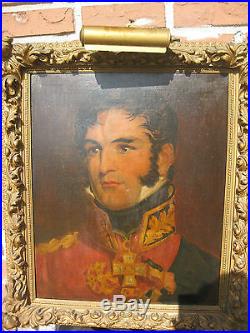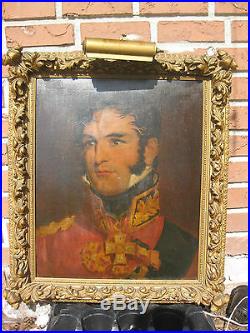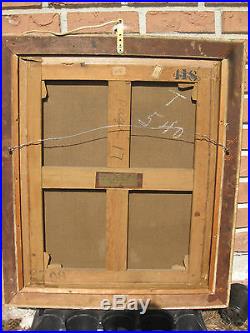belgians
now browsing by tag
19th
24x36
abstract
acrylic
american
antique
artist
artwork
blue
canvas
century
contemporary
decor
female
fine
flowers
frame
framed
french
girl
hand
huge
impressionism
impressionist
landscape
large
life
modern
nude
original
paint
painted
painting
paintings
peter
portrait
rare
scene
seascape
signed
still
stretched
vintage
wall
woman
Portrait of Leopold I, King of Belgians, oil painting on canvas, circa 1820













Possible attribution of the historical person on the portrait. 1 Portrait of Prince Leopold I of Saxe-Coburg by George Dawe. The other two attributions are not likely and the inscription on the painting was made lately by mistake. 2 Portrait of British General Sir Thomas Picton, killed in action at Waterloo, in 1815. 3 Prince Joachim Murat, King of Naples, brother in law of Emperor. Sir William Beechey (1753 – 1839). Jacques-Louis David (1748 1825). Sir Martin Archer Shee (1769 1850) – high probability. Size of the frame: 29 x 25 = 72.5 cm x 62.5 cm. Size of the stretcher: 24 x 20 = 60 cm x 50 cm. Weight of the frame: 15 lb. = 6.75 kg. The lamp on the top of the frame was removed. In the right upper corner there is a message in English. Served in Paris under the Duke of Wellington. Killed in action and _____________Cavalry 1815. At the back of the frame there is inscription in old ink. The painting is not signed. Bought in Paris, France, in 1945, after Second World War. More provenance is available on demand. Version of Leopold I, King of Belgians. Leopold I (Léopold Georges Chrétien Frédéric ; 16 December 1790 10 December 1865) was from 21 July 1831 the first King of the Belgians, following Belgium’s independence from the Netherlands. He was the founder of the Belgian line of the House of Saxe-Coburg and Gotha. His children included Leopold II of Belgium. And Carlota of Mexico. Empress-Consort of Maximilian I of Mexico. He was a maternal uncle and adviser of Queen Victoria. He was born in Coburg. And died in Laeken. By birth, he was a Prince of Saxe-Coburg-Saalfeld. Later a Prince of Saxe-Coburg and Gotha. And Duke of Saxony. Leopold was the youngest son of Francis, Duke of Saxe-Coburg-Saalfeld. And Countess Augusta Reuss-Ebersdorf. And later became a prince of Saxe-Coburg and Gotha. After Saxe-Coburg acquired Gotha from Saxe-Gotha-Altenburg. In 1826 and yielded Saalfeld to Saxe-Meiningen. In 1795, as a mere child, Leopold was appointed colonel of the Izmaylovsky Guards Regiment in Russia. Seven years later, he became a major general. When Napoleonic troops occupied the Duchy of Saxe-Coburg in 1806 Leopold went to Paris. Emperor Napoleon I offered him the position of adjutant, but he refused. Instead, he took up a military career in the Imperial Russian Cavalry. He campaigned against Napoleon and distinguished himself at the Battle of Kulm. At the head of his cuirassier. In 1815, at the age of 25, Leopold reached the rank of lieutenant general. In the Imperial Russian Army. Version of Prince Murat. Prince Murat is a title created by Emperor Napoleon I. For his brother-in-law Joachim Murat. Who would serve as King of Naples. On the 5 December 1812 Joachim’s second son Lucien. Was also created sovereign Prince of Pontecorvo. In the Kingdom of Naples. , in succession to Jean-Baptiste Jules Bernadotte. By an Imperial Decree. The Prince of Pontecorvo title is still used to this day for the heir to the Prince Murat. Version of British General Thomas Picton. The portrait was probably made in his younger years and the writing on obverse was made in 1815 or couple of years later. Appearance of Thomas Picton. In person Captain Picton was at this time tall and well proportioned, approaching the athletic ; his height about 6 feet one inch, and his features large but well formed. The natural expression of his face was stern and dignified; but his smile dispelled at once a repulsive expression, which sometimes hung upon his brow. None whoever saw that smile could deny that it betokened a warm and generous heart. His eyes were brilliant and expressive; his voice sharp , and his manner of speaking quick and animated. But in the field, his tone of voice was totally altered; it was there full and deep. Every word was calm and impressive, and its effect upon his soldiers was apparent in the increased confidence of their charge. Picton, thus resolved to prepare himself for any rank in his profession to which fortune might elevate him, applied with ardour to every persuit. And it was during this long interval of privacy that he laid the foundation of his after fame, and qualified himself to compete for a place among the heroes of his country. Memoires of Lietenant General Sir Thomas Picton V1, Part 1. Including his correspondence, from originals in posession of his family (1836), p. Biography of Thomas Picton. Picton was the younger son of Thomas Picton, and was born in Poyston. In 1771 he obtained an. 12th Regiment of Foot. But he did not join until two years later. The regiment was then stationed at. Where he remained until he was made. The regiment was disbanded five years later, and Picton quelled a mutiny amongst the men by his prompt personal action and courage, and was promised the rank of. He did not receive it, and after living in retirement on his father’s estate for nearly twelve years, he went out to the. In 1794 on the strength of a slight acquaintance with Sir John Vaughan, the commander-in-chief, who made him his aide-de-camp and gave him a captaincy in the. Shortly afterwards he was promoted major in the. Career in the New World. Lieutenant colonel of 56. Foot at St Lucia and St Vincent. Senior Member of Commission of Trinidad. Local rank of lieutenant-general, Spain. Knight of the Order of the Bath. By the Prince Regent. And in June he was made a. He received for the seventh time the thanks of the. For his great services. He was made a. Or Dame Grand Cross. The Most Honourable Order of the Bath (formerly The Most Honourable Military Order of the Bath). On 18 May 1725. The name derives from the elaborate. Ceremony for creating a. (as a symbol of purification) as one of its elements. The knights so created were known as Knights of the Bath. High command in the Anglo-Dutch army. Killed at the battle of Waterloo. General Sir Thomas Picton c. Who succeeded Vaughan in 1795, he was present at the capture of. After which he was promoted to. And then that of. After the reduction of. Abercromby made Picton governor of the island. For the next 5 years he held the island with a garrison he considered inadequate against the threats of internal unrest and of reconquest by the Spanish. He ensured order by vigorous action, viewed variously as rough and ready justice or as arbitrary brutality. In October 1801 he was. During the negotiations leading to the. Many of the British inhabitants petitioned against the return of the island to Spain; this together with Picton’s and Abercromby’s representations, ensured the retention of Trinidad as a British possession. By then, reports of arbitrariness and brutality associated with his governorship had led to a demand at home for his removal. Mistress was believed to be corruptly influencing his decisions. Furthermore, Trinidad no longer faced any external threat, the. Ministry had fallen and the new. Administration did not want Trinidad to develop the. (17541808) was appointed as the Senior Member of a commission to govern the island. Became the second member, and Picton himself the junior. Fullarton had a very different background from Picton. He came from a wealthy and long-established Scots land-owning family and was a. A Fellow of the. An improving landlord, and a patron of. He had been a junior diplomat, before in the course of the. American War of Independence. Raising a regiment of which he naturally became the Colonel. He ended that war in India commanding an army of 14,000 men in operations against. Following which he had written an influential pamphlet arguing that the. Had brought trouble on itself by its unprincipled treatment of native princes and native subjects and that a more humane policy than “let them hate so long as they fear” would be more effective in securing its position. The new Secretary of State for the Colonies. Had served as Governor of Madras soon after the pamphlet came out, knew Fullarton, and had been influenced by his views. Picton’s policy with respect to various sections of the island population had effectively been “let them hate so long as they fear” and he and Fullarton rapidly fell out. This, of itself, further worsened the rift: Fullarton’s Indian pamphlet had also reported adversely on conflicts of interest and dissension between the English having weakened their ability to govern well, to negotiate effectively, and to effectively defend their possessions. Fullarton commenced a series of open enquiries on allegations against Picton and reported his unfavourable views on Picton’s past actions at length to meetings of the commission. Picton thereupon tendered his resignation and was soon followed by Hood (1803). Picton joined Hood in military operations in St Lucia and. To face charges brought by Fullarton. In December 1803 he was arrested by order of the. The majority of the charges against Picton were dealt with by the Privy Council. They related principally to excessive cruelty in the detection and punishment of practitioners of. Severity to slaves, and of execution of suspects out of hand without due process. Only the latter class of charge seems to have seriously worried the Privy Council, and here Picton’s argument that either the laws of Trinidad, then still the laws of the former Spanish colonial power, or’the state of the garrison’ justified the immediate execution in the cases specified eventually carried the day. He was, however, tried in the court of King’s Bench before. In 1806 on a single charge; the. Torture (but not the specific form) had been requested in writing by a local magistrate and approved in writing by Picton. Was a version of a British military punishment and consisted in principle of compelling the trussed up suspect to stand on one toe on a flat-headed peg for one hour on many occasions within a span of a few days. In fact Luisa was subjected to one session of 55 minutes, and a second of 25 minutes the following day. The period between Picton’s return and the trial had seen a pamphlet war between the rival camps, and the widespread sale of engravings showing a curious British public what a personable 14-year-old mulatto girl being trussed up and tortured in a state of semi-undress might look like. The legal arguments, however, revolved on whether Spanish law permitted torture of suspects: on the evidence given, the jury decided that it did not and Picton was found guilty. Picton promptly sought a retrial, which he got in 1808. At this, other credible witnesses were brought forward by Picton’s supporters to testify to the (Spanish) legality of torture, its application in the recent past, and that Luisa Calderon had been old enough to be legally tortured. The jury reversed the verdict of the earlier trial but asked for the full court to consider the further argument of the prosecution that torture of a free person was so repugnant to the laws of England that Picton must have known he could not permit it. Whatever Spanish law authorized. The full court never reached a decision on this; there were legal precedents to this general effect from the British occupation of. And a practical precedent from the British seizure of the. Cape of Good Hope. From the Dutch, but it remained to demonstrate that Picton should have known this, and by now Fullarton was dead and Picton a war hero. Friends of Picton in the military and among slave owners subscribed towards his legal expenses. In 1810, at Wellington’s request, he was appointed to command a division in Spain. For the remaining years of the Peninsular War, Picton was one of Wellington’s principal subordinates. The commander-in-chief, it is true, never reposed in him the confidence that he gave to. But in the resolute, thorough and punctual execution of a well-defined task Picton had no superior in the army. His debut, owing partly to his naturally stern and now embittered temper, and partly to the difficult position in which he was placed, was unfortunate. In July 1810 Craufurd’s division became involved in an action, and Picton, his nearest neighbour, refused to support him, as Wellington’s direct orders were to avoid an engagement. Shortly after this, however, at. Picton found and used his first great opportunity for distinction. Here he had a plain duty, that of repulsing the French attack, and he performed that duty with a skill and resolution, which indicated his great powers as a troop-leader. After the winter in the. Lines of Torres Vedras. He added to his reputation and to that of his division, the’Fighting’ 3rd, at the. Battle of Fuentes de Onoro. In September he was given the local rank of lieutenant-general, and in the same month the division won great glory by its rapid and orderly retirement under severe pressure from the French cavalry at El Bodon. In October Picton was appointed to the colonelcy of the. 77th Regiment of Foot. In the first operations of 1812 Picton and Craufurd, side by side for the last time, stormed the two breaches of. Craufurd and Picton’s second in command, Major-General. A month later, the successful storming of the fortress was due to his daring self-reliance and penetration in converting the secondary attack on the castle, delivered by the. Into a real one. He was himself wounded in this terrible engagement, but would not leave the ramparts, and the day after, having recently inherited a fortune, he gave every survivor of his command a guinea. His wound, and an attack of fever, compelled him to return to Britain to recoup his health, but he reappeared at the front in April 1813. While in Britain he was invested with the collar and badge of a. Picton led his division across a key bridge under heavy fire. According to Picton, the enemy responded by pummeling the 3rd with 40 to 50. And a counter-attack on their right flank (which was still open because they had captured the bridge so quickly) causing the 3rd to lose 1,800 men (over one third of all Allied losses at the battle) as they held their ground. The conduct of the 3rd division under his leadership at the. And in the engagements in the. Raised his reputation as a resolute and skilful fighting general to a still higher point. Early in 1814 he was offered, but after consulting Wellington declined, the command of the British forces operating on the side of Catalonia. He thus bore his share in the. And in the final victory before. On the break-up of the division the officers presented Picton with a valuable service of plate, and on 24 June 1814 he received for the seventh time the thanks of the. Somewhat to his disappointment he was not included amongst the generals who were raised to the peerage, but early in 1815 he was made a. Picton, at Wellington’s request, accepted a high command in the Anglo-Dutch army. He was severely wounded at. On 16 June, but concealed his wound and retained command of his troops. Two days later, while in command of the. While repulsing with impetuous valour “one of the most serious attacks made by the enemy on our position”, he was shot through the temple by a musket ball, making him the highest ranking victim of the battle on the allied side. Since his luggage had not arrived in time, he had fought the battle wearing civilian clothes and a. Welsh folklore says that his top hat was shot off by a. Moments before his death, but this is not known to be backed by any historical source. Family folklore contends that he did not ride out in tails but in his night shirt and top hat because he had overslept, and he died at the hands of one of his own men who shot him in the back of the head because they hated him so much. Again this is not backed by any historical source. Announcing his death in his typically laconic style, Wellington wrote to Minister of War, Lord Bathurst. In Lieutenant-general Sir Thomas Picton, his majesty has sustained the loss of an officer who has frequently distinguished himself in his service; and he fell, gloriously leading his division to a charge with bayonets, by which one of the most serious attacks made by the enemy of our position was defeated. His body was brought home to London, and buried in the family vault at. St George’s, Hanover Square. A public monument was erected to his memory in. St Paul’s Cathedral. By order of parliament, and in 1823 another was erected at. By subscription, the king contributing a hundred guineas. The Duke of Wellington, painted in 1814, several months before the Battle of Waterloo, by the artist Sir Thomas Lawrence. The item “Portrait of Leopold I, King of Belgians, oil painting on canvas, circa 1820″ is in sale since Monday, August 6, 2012. This item is in the category “Art\Paintings”. The seller is “ukr10″ and is located in Clearwater Beach, Florida. This item can be shipped worldwide.
- Original/Reproduction: Original
- Listed By: Dealer or Reseller
- Signed?: Unsigned
- Medium: Oil
- Subject: Celebrities & Musicians
- Style: Realism
- Size Type/Largest Dimension: Medium (Up to 30″)
- Date of Creation: Pre-1800
- Region of Origin: Europe


 D5 Creation
D5 Creation